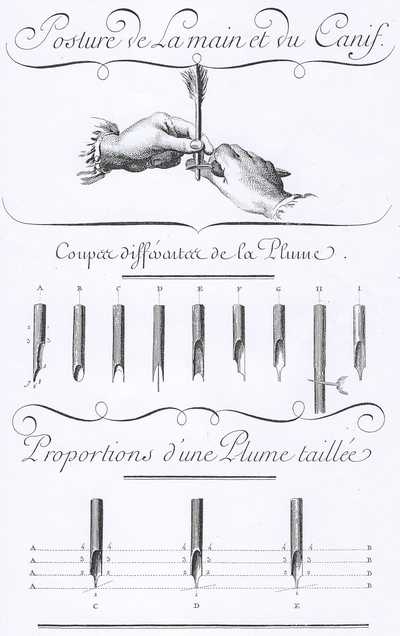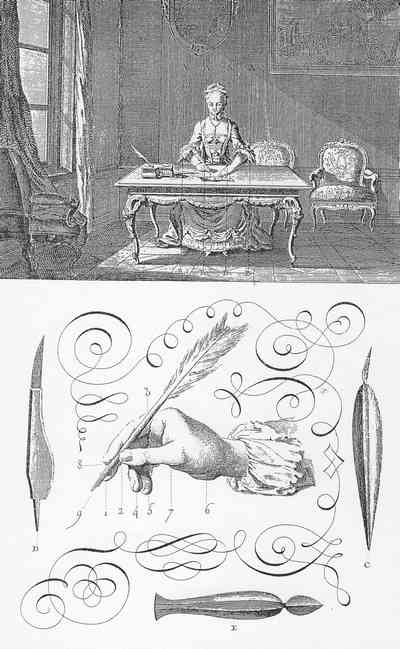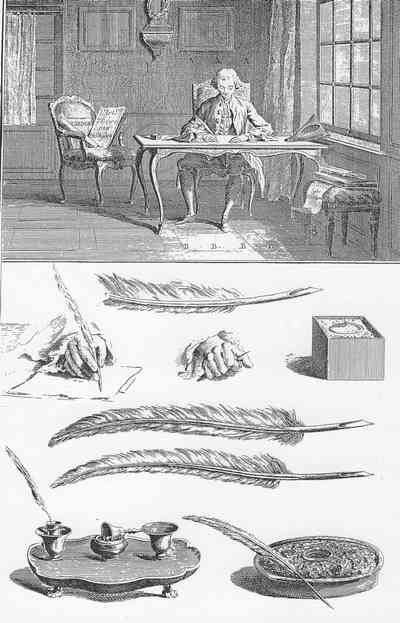In the 18th century, Auvillar became famous for its earthenware. Another profession, quite rare, almost unique in France, also made the city famous: the preparation and export of the writing quill pen. Favored by a region of denser poultry farms, production amounted to several hundreds of thousands of feathers at the end of the 18th century, and was exported to the Levant and Spain. Each goose wing produced only a few high quality feathers (flight feathers) called “brand feathers” with very wide barrels. Often, the craftsman would sell his production himself at Beaucaire or Bordeaux fairs, after the creation of the Canal du Midi. These fairs gathered “the Germanic hanse”, association of German merchants having the monopoly of the trade by water, from the North Sea to the Baltic, and who were great amateurs and buyers of our feathers for their quality. The rapid spread of the metal pen, which appeared in England in the middle of the 19th century, came to put an end to this local industry.

Pen preparation:
Before its use, the writing pen underwent a rather complex treatment which could last several days, and which consisted in making the barrel harder, for a better and durable use. Before the cutting which was done using special knives, very difficult to find today, this treatment, called quenching and clarification, required great attention and great manual skill on the part of the manufacturer to handle the fire, the and sand needed for this operation. The craftsman’s skill and experience depended on a reputation for quality that sometimes crossed borders, as was the case in Auvillar. Usually, the feathers of geese, swans, turkeys were used for writing of medium or large size. As for those of ducks and crows, they are rather intended for the finest writings and the drawing, the latter being small and difficult to hold: one can cut their tank and insert it in a piece of wood or reed, to better grip, ancestor of the modern pen holder. The practice of using feathers goes way back in time. At the British Museum, Egyptian paintings depict scribes using this instrument. The Romans used it on vellum (calf or sheep skin prepared for writing – around 190 BC). In the Middle Ages, different species of birds were used: the pelican, the pheasant, the eagle, the peacock and the crow.
For the turkey or the goose with many penne, the first five pipes are usually used: the flight feathers. The sixth or seventh pinnae are rather reserved for very fine drawing, as are the rectrices or feathers of the tail. The feathers, the pipe of which points to the right when held in the writing hand, come from the left wing. Some calligraphers prefer them to the feathers of the right wing, which point to the left. The most favorable time for collection coincides with that of the moult, since the feathers are then in a period which facilitates their subsequent treatment. A feather consists of three parts: the pipe, the tank and the barbs with their barbs. In its natural state, the reservoir is covered with a kind of greasy skin enclosing the marrow, and which therefore tends to soften it. In order to remedy this, the pen must be hardened. Before pruning, the pen should be stripped of the fatty membrane that surrounds the pipe. These different transformation techniques, called “quenching” and “clarification”, varied according to the times and the experience of the craftsmen.
Tempering:
This method used in the 18th century consists in moistening the goose feathers, either by placing them in a humid cellar for a day or two, the beak of the feather in the ground, or by wrapping them in a damp cloth, several hours before treat them. Through the grate of a fire, introduce the feather tank so that it does not touch the fire, but is well heated in all respects. The feather thus heated will be passed under a hot metal plate, with a smooth surface. This process removes the membranous substance covering the reservoir and gives it a very round shape. Then repeat the operation by reversing the position of the tank. Return it to its original shape on the fire. The pressure under the plate having previously flattened it. Note that if the feather has not been sufficiently moistened, it may crack on the sides. This work requires very close attention. Finally, rub the feather before polishing it. Another method is to cut the tip of the feather at an angle and place it in hot ashes. Remove the outer membrane by scraping the tank with the back of the blade of a knife, then file the feather by rubbing with a woolen cloth. You can also wet the tank, then holding it over a charcoal fire, scrape it off with the knife.
Clarification:
According to this 17th century process, start by removing the outer film from the pen by scraping and then cutting off its end. Then immerse it in boiling water containing a small amount of alum and salt. After 15 minutes, dry it in a pan of hot sand and then in an oven. In the 18th century, the method of clarification differed significantly. It consists of tying the feathers in a bundle (but not tightening them too much), and placing them in a pot in a steamer, so that they do not touch the water. Then just cover them with a lid and let the steam act for an hour. Then you have to take them out and dry them by a fire. The next day, all that remains is to scrape the tanks with the back of a knife, and smooth them with a woolen cloth. After several days, we can use these feathers. Beak size and incision are possible. However, performed too early, when the material is still soft, the incision may not be straight and clean.
The size of the feathers:
We start by shortening the pen, tearing out the superfluous barbules and removing the duvets. The instrument having been hardened, we cut obliquely the end of the side of the belly, we do the same for the back, then we incise the slit on this side with the edge of the knife that we slide into the pipe, taking be careful not to push the blade too far. Indeed, it is always better to enlarge the slot by bursting, which has the advantage of keeping it closed. Through the channel thus formed will flow the ink. Then we turn the pen over and make a big opening on the belly, we hollow out the end on either side of the slit. Finally, to trim the beak, place the underside of the pen on a hard, smooth surface, and place the penknife on the cutting edge where you want to cut. This last stroke which the masters of art call “tact” must be done subtly, in a lively and clean manner. This size dates from the 18th century. Such a profession did not require large or bulky equipment. On the other hand, it obliged the craftsman to a constant surveillance and the permanent control of the heat, the humidity during the manipulations which did not suffer from any error, to reach the perfection required by calligraphers and professional users of the time. . It also required a perfect knowledge of the quality of the different feathers, in order to submit them to a real and difficult work of artist.


